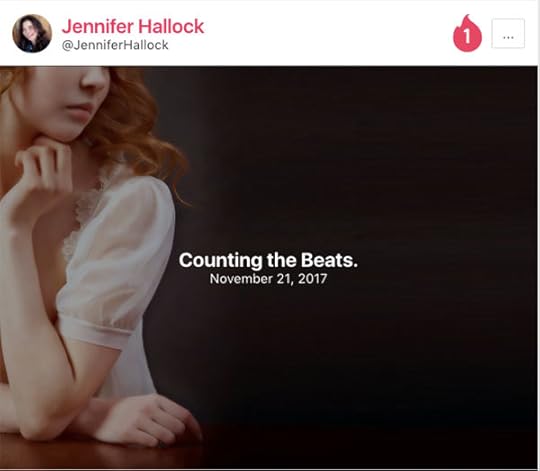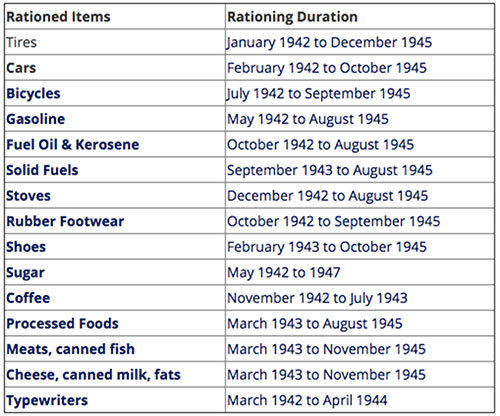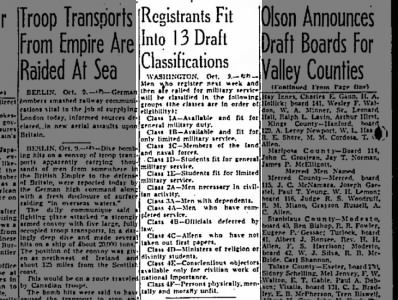Jennifer Hallock's Blog: Sugar Sun Series Extras, page 12
December 26, 2017
Gilded Age Buckeyes
In preparation for the upcoming Cotton Bowl Classic, featuring Ohio State versus UCLA, I dug up some old Buckeye football photos. Just because they’re awesome.
 The 1890 football team, courtesy of Wikimedia Commons. (Look at that ball?!)
The 1890 football team, courtesy of Wikimedia Commons. (Look at that ball?!) The 1897 Ohio State Buckeyes, courtesy of the OSU library. Those guys look pretty comfortable with each other. Someone write this book, please?
The 1897 Ohio State Buckeyes, courtesy of the OSU library. Those guys look pretty comfortable with each other. Someone write this book, please? Ohio State University football legends Gaylor “Pete” Stinchcomb (left) and Chic Harley (right) pose for a photograph taken between 1916 and 1919. Photo courtesy of the Ohio History Connection and captioned by the Dayton Daily News.
Ohio State University football legends Gaylor “Pete” Stinchcomb (left) and Chic Harley (right) pose for a photograph taken between 1916 and 1919. Photo courtesy of the Ohio History Connection and captioned by the Dayton Daily News. The Ohio State football team plays outside of the recently completed Ohio Stadium in 1923. At the time of the its completion in 1922 the stadium was the largest west of the Allegheny Mountains. Photo courtesy of the Ohio History Connection and captioned by the Dayton Daily News.
The Ohio State football team plays outside of the recently completed Ohio Stadium in 1923. At the time of the its completion in 1922 the stadium was the largest west of the Allegheny Mountains. Photo courtesy of the Ohio History Connection and captioned by the Dayton Daily News.Banner image from the spectacular 1916 season, the Buckeyes’ first undefeated and untied season and their first Big Ten Championship. O-H! I-O! Beat the Trojans!
December 19, 2017
Sugar Sun series glossary term #34: piña

Javier knows perfectly well that his piña fiber is uniquely delicate, transparent, well-ventilated, yet strong. This combination is why piña is the traditional choice for a man’s barong tagalog or a woman’s wedding dress or fancy blouse.
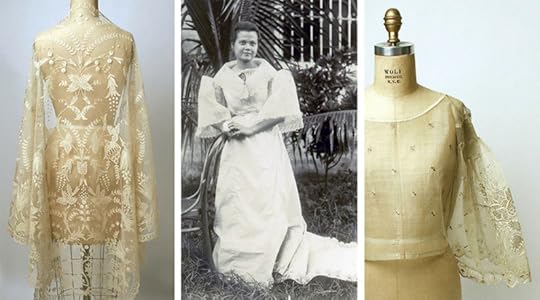 From left to right: 19th-century piña shawl from the Metropolitan Museum of Art; Philippine-German mestiza wearing a baro’t saya from the Philippine Photographs Digital Archive; and a piña blouse, also from the Met.
From left to right: 19th-century piña shawl from the Metropolitan Museum of Art; Philippine-German mestiza wearing a baro’t saya from the Philippine Photographs Digital Archive; and a piña blouse, also from the Met.But fine piña is not cheap, with good reason. Every part of its production is time-consuming, starting with the 18 months it takes a pineapple plant to reach maturity. Starting at about a year of growth, the plant’s leaves can start to be cut and processed for their fibers. According to the Philippine Folklife Museum:
The green epidermal layer is scraped off the leaf with tools made from coconut shells, coconut husks or pottery shards. Extraction from the long, stiff leaves is time-consuming and labor-intensive. These fibers are then spun into soft, shimmering fabrics by hand. Because the fiber is fine and breaks easily, working with it is slow and tedious. Workers are constantly knotting broken threads.
That is not the end of the process, either. It takes weeks more to prepare the yarn and then weave it together into patterns like flowers, fruits, coconut trees, and nipa huts—whatever the artist wants. According to the Folklife Museum, it can take eight hours to finish one meter of plain cloth or just half a meter of patterned cloth.
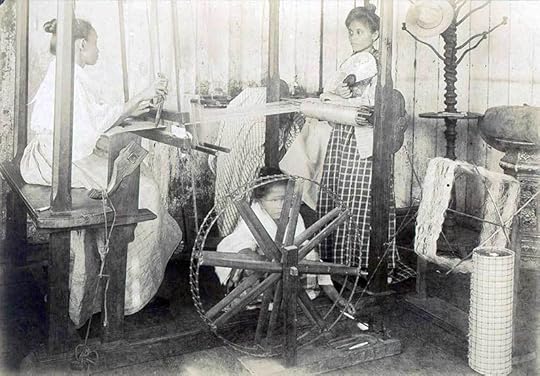 Turn-of-the-century photo of girls weaving piña from the Philippine Photographs Digital Archive at the University of Michigan at Ann Arbor.
Turn-of-the-century photo of girls weaving piña from the Philippine Photographs Digital Archive at the University of Michigan at Ann Arbor.All to make ladies look gorgeous and men look handsome? Yeah, it’s worth it.
[Featured public domain image of an early 19th-century piña scarf was a gift of Miss Mary Cheney Platt to the Met.]
December 12, 2017
Sugar Sun on Book+Main Bites
Do you want to taste test your books? The Book+Main folks heard you, and they created a site where you can even search by trope. For example, do you want more marriage of convenience? Me too. I love those, which is why I wrote one.
Best of all, this app is free for readers! You can find my bites there, or you can explore authors new to you. (Check out the “discover” tab.) Best of all, the site is so pretty with its clean, uniform look. Here’s a few of mine to tease you…
Head on over and discover new books now!
December 6, 2017
History Ever After: Sydney 2018
Love is global. One gift my writing has brought me is a connection with several awesome Australian reviewers, including Kat Mayo at Book Thingo and Dani St. Clair at Romancing the Social Sciences. (Check out these two awesome sites!)
I missed Kat at #RT16, but she told me about a different kind of romance conference that was happening in Sydney in June 2018: the International Association for the Study of Popular Romance’s “Think Globally, Love Locally?”
But, whoa, academia. I chose to stop after my master’s degree and teach high school instead of university so that I could avoid the pressures of “publish or perish.” (And publish what I wanted to publish, i.e. romance.) But this conference! This looked cool, and I applied. Lo and behold, they accepted my presentation, “History Ever After: Fabricated Historical Chronotopes in Romance Genre Fiction.” Now I have to put it together.
Here is the gist of my investigation:
A few popular Eurocentric chronotopes dominate romance fiction, especially Regency/Victorian England, the Scottish Highlands, and the American West. Though these three periods were filled with armed conflict, political exploitation, and societal change, some publishers have discouraged authors from putting these conflicts on the page, let alone tackle a new setting altogether. My presentation will investigate geographic and historical diversity in new romance and compare it to the original inspirations of the genre. Specifically, I will be looking at online retailer subject groupings, series romance lines, recent Big Five historical romance titles, and the growing body of work by independent authors and smaller presses. I will also be interviewing both traditionally published and independently published authors, as well as editors, bloggers, and reviewers.
Just warning you, I am probably going to pick your brain in this process. I might be making a survey. I certainly will be talking to as many people as possible.

I especially need to crowd-source some book recommendations. If you know of historical romance books that may be of interest to this project, please add them to one of these two Goodreads lists:
For books outside of 19th century England (Regency/Victorian), Scotland, and the American West, click here.
For books (in any historical time period) that include political, military, or socio-economic conflict or complexity, click here.
Thank you for your help! You’ll be hearing from me.
November 29, 2017
Christmas under the Sugar Sun
Click the image below for a peek into the world of the Sugar Sun series. Experience the daigon, or Christmas pageant, with Javier and Georgina of Under the Sugar Sun. The link will take you to Instafreebie, where you can download chapter 29 of the novel in the format of your choice.
Happy holidays, everyone! Maligayang Pasko!
And have you signed up for the Sugar Sun newsletter yet? The holiday wrap-up is coming soon. Make sure to get all the latest updates on Sugar Moon by registering here!
November 27, 2017
Update on Sugar Moon (Book Four of the Sugar Sun series)

The very good news: the first draft of my major revision of Sugar Moon is done. (I basically cut out and rewrote the middle. Yikes!)
More good news: The book is so much better, I promise. And there is a baseball diamond proposal scene that is adorable.
The other good news: it only took me 37k words to do it. Sweet.
The bad news (for the perfectionist side of me): I won’t finish NaNoWriMo my very first year of participating. That’s sort of a bummer, but this program did what I needed it to do. It got me to tackle this mammoth project in just one month.
Now I get to revise, revise, revise. But before I go, I will leave you with my latest teaser, which happens to be the first nine lines of the book (as of now):

November 22, 2017
Thanksgiving Over There in the Philippine-American War
I spent many Thanksgivings in the Philippines, and it was great. We had some fun parties, including one at our farm. But it was also a little bit of a letdown because it was a normal workday for me, and I did not get to watch football live. Now I have a little time off: my exams are graded and student comments written, so wheeeee! And, like in recent years, we will celebrate “Friendsgiving” in New England with two vegetarians. Meh, I’m not big into Turkey, anyway, so I’ll take it.
 30TH VOLUNTEER INFANTRY REGIMENT: Thanksgiving dinner for the men of Company “D”, 30th Volunteer Infantry Regiment in the outer Manila trenches at Pasay. The photo was taken on November 24, 1899 and shows the men sitting down to their meal laid out on a long bamboo table protected from the hot sun by a canvas awning. The Soldiers from Company “D” are wearing their blue Army service shirts and campaign hats. Some of the men wear a special red kerchief around their necks, which later became a hallmark of the regiment and earned them the nickname, “The men in the crimsom scarves.” Company D was lead by Captain Kenneth M. Burr throughout their tour in the Philippine Islands. Photo uploaded by Scott Slaten on the Philippine-American War Facebook Group.
30TH VOLUNTEER INFANTRY REGIMENT: Thanksgiving dinner for the men of Company “D”, 30th Volunteer Infantry Regiment in the outer Manila trenches at Pasay. The photo was taken on November 24, 1899 and shows the men sitting down to their meal laid out on a long bamboo table protected from the hot sun by a canvas awning. The Soldiers from Company “D” are wearing their blue Army service shirts and campaign hats. Some of the men wear a special red kerchief around their necks, which later became a hallmark of the regiment and earned them the nickname, “The men in the crimsom scarves.” Company D was lead by Captain Kenneth M. Burr throughout their tour in the Philippine Islands. Photo uploaded by Scott Slaten on the Philippine-American War Facebook Group.Thanks to the Philippine-American War Facebook group, and especially Scott Slaten, for posting these. If you are interested in this war at all, you really should follow this group. It’s free, and the photos are amazing.
 30th INFANTRY REGIMENT, USV – Thanksgiving Day at Pasay, outer Manila trenches with the 2nd Section, Company G, 30th Infantry Regiment USV, November 1899. The photo shows the men with their Krag rifles stacked on the street of their small camp. Note the sign for the 2nd Section in the middle of the photograph. Photo uploaded by Scott Slaten on the Philippine-American War Facebook Group.
30th INFANTRY REGIMENT, USV – Thanksgiving Day at Pasay, outer Manila trenches with the 2nd Section, Company G, 30th Infantry Regiment USV, November 1899. The photo shows the men with their Krag rifles stacked on the street of their small camp. Note the sign for the 2nd Section in the middle of the photograph. Photo uploaded by Scott Slaten on the Philippine-American War Facebook Group.These are nice reminders that even in war, people celebrate holidays and birthdays. They even fall in love. (That’s where we historical romance authors come in.) But no doubt, what these men’s families wanted to know was not whether they were having a good time, but when they would be coming home. A year later, they would get their answer:
 From the November 22, 1900, edition of the Washington Post.
From the November 22, 1900, edition of the Washington Post.Since most of these soldiers had originally volunteered for what they had thought was a brief war in Cuba, this was probably a relief. Some did re-enlist as regulars, which meant a much longer commitment.
For your Sugar Sun readers out there, here’s a little Thanksgiving tidbit for you: Pilar Altarejos, daughter of Javier and Georgina, was born on Thanksgiving 1903. I thought it was appropriate—being thankful for being together, how romantic!—and I thought it would get Javier’s nationalist back up a little. (Yes, I’m terrible.)
Hopefully, wherever you are, I hope you have a great week. The best thing about this holiday is the reminder to be grateful for something. I am grateful for so many things, but I want to add you, my readers, to that list. Thank you for reading and for following the Altarejos clan through all its ups and downs. More adventures in love will be coming, I promise!

November 17, 2017
Living through the Big One, Looney Tunes Style
I set my historical romance characters in the midst of some trying times: revolution, colonial conquest, insurrection, epidemic, and more. As author extraordinaire Beverly Jenkins said at #RT17: “Even in the toughest times, people still love, still have birthday parties, still have picnics.”
For example, even in the middle of World War II, they still had cartoons. And they were not escapist entertainment, either. They dealt with world events head-on. I recently saw two of these cartoons at random while watching the Looney Toon Network, as one does.
“Tortoise wins by a hare” (1943):
You can guess the premise:

This front page of the Chicago Sunday Tribunk is a spoof of the actual Tribune from November 1, 1942 (see below), with all the same stories except the headline . . . and one other. Can you guess which one that Looney Tunes added? Look closely. Do you see “Adolph Hitler Commits Suicide?” in the bottom right? This is one and a half years before Hitler and Eva Braun really killed themselves (and their dog), with cyanide pills in a bunker below Berlin.

Yes, the Allies wanted Hitler dead one way or another, as did some of his own generals, but I do not think suicide was what they expected. When the Tribune really did report this news for real, they had to source it to the Soviets because they did not believe it. But Looney Tunes hit it on the nose.
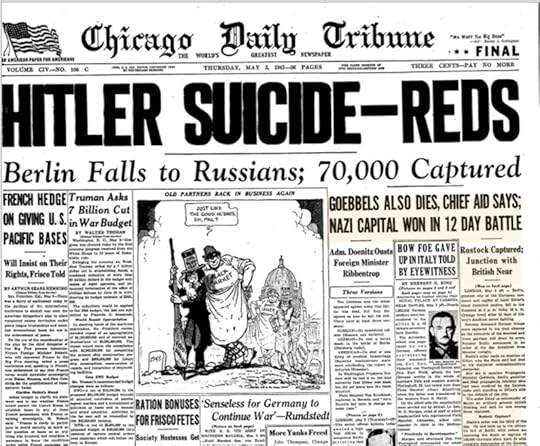
Okay, on to the funny bits. Bugs Bunny really wanted to beat the tortoise in the cartoon, and he claimed to have a secret weapon. What is it? Take a look.
 This is the whole joke: a frame showing Bugs with mileage ration cards, A and C. The C card is the score, but everyone would have known that at the time. Would you like me to explain it? Okay, remember that in the 1940s all essential goods were rationed. Check out this list from the Ames (IA) Historical Society:
This is the whole joke: a frame showing Bugs with mileage ration cards, A and C. The C card is the score, but everyone would have known that at the time. Would you like me to explain it? Okay, remember that in the 1940s all essential goods were rationed. Check out this list from the Ames (IA) Historical Society:
The general public was issued a ration sticker marked “A,” and this limited the amount of gasoline you could buy. But, if like Bugs, you got a C emblem, or supplemental mileage ration, you could get more gas. The C designation was reserved for specific professionals: Red Cross officials, school officials, mail and newspaper deliverers, journalists, surgeons, nurses, veterinarians, embalmers (!), ministers and rabbis, farm workers, industrial workers, soldiers, scrap collectors and more. Check out the illustrations below from the Ames Historical Society or Cartype, and go to their sites to see all the stickers available. To get a C supplemental ration was a big deal, and everyone who saw this cartoon knew it. The joke was quick, funny, and entirely of the moment.

“The Blue Danube” from “A Corny Concerto” (1943):
This cartoon was a parody of Disney’s “Ugly Duckling: A Silly Symphony.” What looks like a baby Daffy Duck tries to swim with a swan family, but the mother keeps rejecting him. And Mama Swan is not the only one. A hungry vulture tries to snatch up all the swanlings, and he grabs baby Daffy by mistake. But then he promptly puts Daffy back, with a plunger marked “Rejected 4F.”

What the heck is 4F, you ask? Some of you will know, especially children of the 1960s, that it is a draft classification. I-A meant “Available for unrestricted military service,” or, in other words, don’t make plans. You’re going to be drafted. Look down the list—far, far, down down the list for IV-F.
IV-F is: “Registrant not acceptable for military service due to physical, mental, or moral defect.” Being labeled 4F was a stigma for most men at the time—well, for everyone except Frank Sinatra, the “most hated man in World War II,” who got to croon to wives and girlfriends Stateside while other men were off at war. From the New York Times:
Sinatra repeatedly said on draft forms that he had ”no physical or mental defects or diseases,” as he wrote on one. But when he arrived at the Jersey City induction office in December 1943, he gave Army doctors plenty of reasons to reject him. He told them that an ear injury at birth and subsequent operations were still causing ”running ear” and ”head noises.” Furthermore, he claimed to be ”neurotic, afraid to be in crowds, afraid to go in elevator, [wants] to run when surrounded by people” and had ”been very nervous for four or five years.” He also complained that he ”wakens tired in the a.m., is run down and undernourished.”
Sinatra afraid of crowds? Hmm…
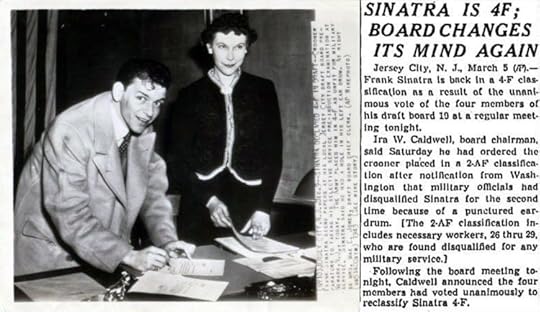 Frank Sinatra signing draft board papers in New York in 1943, and his final 4F decision reached in 1945.
Frank Sinatra signing draft board papers in New York in 1943, and his final 4F decision reached in 1945.Sinatra seems a lot happier about the IV-F than Daffy did.
These two cartoons are not the only wartime Looney Tunes, just the least overly racist ones. (Though the 4F joke was pretty ableist.) What I like about them is how they illustrate both the concerns of the time and that people were still able to find the funny. If you can find the funny, you can find the love, too.
November 11, 2017
The Boys (and Girls) of Fall
I am so excited that Kristen Strassel asked me to help plug her new Real Werewolves of Alaska football-shifter romance series. What is not to like about this idea?
But it may surprise you to know why she asked me of all people. It’s not because I know so much about the history of football…though, did you know that it was a native Ohioan who threw the first legal forward pass in football in 1906? It was incomplete. (That’s the problem with passing, according to one of my co-coaches, Hef: only three things can happen, and two of them are bad.)
 The 28 January 1906 story from the Washington Post on the new forward pass in football.
The 28 January 1906 story from the Washington Post on the new forward pass in football.(Other new rules at this time: the establishment of the neutral zone between the teams before the snap, the redefinition of unnecessary roughness and unsportsmanlike conduct, and a clarification of holding. These were all meant to make football less dangerous.)
But it is not my Gilded Age football knowledge that Kristen wanted. It’s my perspective as a coach. As a part of my day job teaching history, I am a junior varsity football coach. Almost all of our players are boys, but we have had girls on occasion. It says a lot about our head coaches, our players, and the school’s administration that they were willing to take a chance on a mere football fan who desperately wanted to get on the sideline. I had to learn all the Xs and Os from scratch—but the truth is that most coaches start from near-scratch each year, even each game! How did I do it?
 Do those look like trash cans behind Jim and I? In football, we call them barrels, and they are used most often to represent the defensive line and linebackers in practice. (They are not yet set up in this photo.) As we run through a play, each kid knocks over the barrel of their assignment, and that’s how you know your wizardry will work—the first time around. After that, everyone adjusts, and it becomes a little more complicated.
Do those look like trash cans behind Jim and I? In football, we call them barrels, and they are used most often to represent the defensive line and linebackers in practice. (They are not yet set up in this photo.) As we run through a play, each kid knocks over the barrel of their assignment, and that’s how you know your wizardry will work—the first time around. After that, everyone adjusts, and it becomes a little more complicated.Pretty much everything I know was taught to me by co-coach, mentor, and best friend Jim Lockney. (Jim and his wife, Priscilla, are also two of my beta-readers, and Priscilla is the reason there were maps made for Under the Sugar Sun.) Jim and I have had some amazing times on the gridiron—me calling the offense and Jim handling the defense, the special teams, and the offensive line. (Coaching the line is a specialty. It’s almost a whole new sport.)
Why do it at all? What is so special about football? Well, as one of my players said: “Brotherhood. I’ve played lots of team sports, but nothing else comes close.” Now, given that he gave this answer to his female coach, and being aware that we have had girls on the team in his time, I do not think he is being a chauvinist. He means that football is family.
There is no sport that requires this kind of teamwork, where each and every player has a different job, and they have to do their jobs at the same time and in sync. If one of the eleven does the wrong thing, it is a “busted play” and you are likely to lose yards and maybe even the ball. And the players don’t learn just one play, either: they learn twenty (at the youth level) or forty (at the junior varsity level) or eighty (at the varsity level) or hundreds (in the NCAA and NFL)—and each by its code name. They also have to know how each play shifts based upon the defense they see across the line of scrimmage, which is especially true for the linemen. In the end, when a football team moves as one on the field—despite these many, many complications—they are like a hive mind. That is brotherhood.
Read more of my ideas about football at Kristen’s blog. Or just check out her sexy paranormal and contemporary books. Yum!
 From “The Game” in 1918: Ohio State versus Michigan. Unfortunately, this was from the shut-out years when Michigan spanked OSU. I guess they need to win sometimes, right?
From “The Game” in 1918: Ohio State versus Michigan. Unfortunately, this was from the shut-out years when Michigan spanked OSU. I guess they need to win sometimes, right?[Featured image shows a forward pass from the 1921 Auburn-Georgia Tech game.]
November 5, 2017
Sugar Moon revisions in NaNoWriMo
I blew up the middle of Sugar Moon, so now I am NaNoWriMo-ing it to get these new 50k words in. Want to check my progress?

Sugar Sun Series Extras
- Jennifer Hallock's profile
- 38 followers






